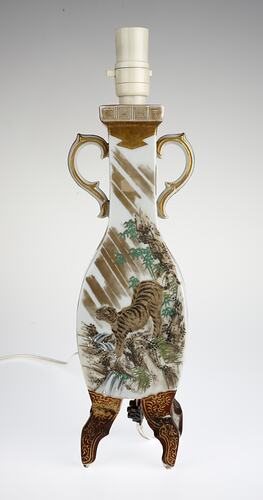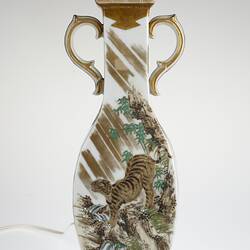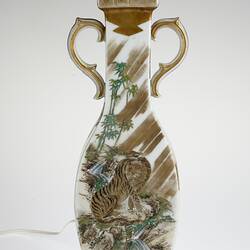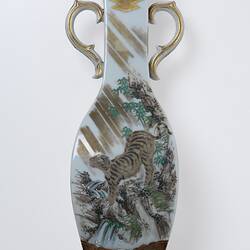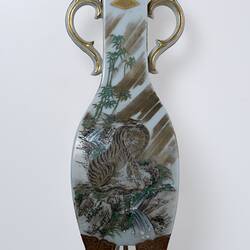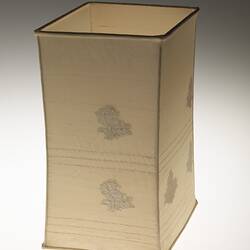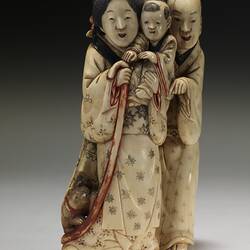Summary
Vase manufactured by Tokyo Hyouchi-en in Fukagawa, Japan, during the early Meiji period between 1873 and 1880. Hyouchi-en was awarded a Fifth prize by the Glass and Pottery jury at the Melbourne International Exhibition; the manufacturers would have received a certificate.
In 1872 the Japanese government established a porcelain factory in Asakusa, Tokyo, specifically to produce material for display at the 1873 Vienna International Exhibition. It was headed by Kawahara Noritatsu (1845-1914). The government sold the factory to Kawahara in 1873 and he subsequently renamed the company Tokyo Hyouchi-en.
In 1900 Kawahara established a factory in Kyoto, known as Kyoto Hyouchi-en. It followed the tradition established at Tokyo Hyouchi-en, decorating porcelain kilned in Seto by the trading company Morimura Group. Kyoto Hyouchi-en was subsumed by the Japanese Pottery Partnership, Nagoya, in 1909. This partnership became known as Noritake, one of the leading companies of Japanese ceramics.
The vase was converted to a lamp in the mid 20th century by a member of the Twycross family. The lamp shade was made by Lallah Dredge. Lallah lived in Brighton and went to Fairbank, the same school as Mary Twycross, John Twycross' granddaughter-in-law.
Physical Description
A two handed vase with bulbous rectangular body on four feet. The body painted with an image on two opposite sides of tigers in natural landscapes. The side panels painted with stylised flower and leaf motifs. The feet painted with gold tendrils on brown-red ground. Signed underneath. The vase has been converted for use as a lamp, and has a silk shade.
More Information
-
Collection Names
-
Collecting Areas
-
Acquisition Information
Cultural Gifts Donation from Dr Will Twycross, 23 Jan 2009
-
Acknowledgement
Donated through the Australian Government's Cultural Gifts Program
-
Manufacturer
-
Place & Date Exhibited
Royal Exhibition Building (REB), Nicholson Street, Carlton, Greater Melbourne, Victoria, Australia, 1880-1881
-
Collector
Mr John Twycross, Elsternwick, Greater Melbourne, Victoria, Australia, 1881
-
Inscriptions
Signed on foot in red paint with three columns of kanji. Signature reads: Tokyo Hyouchi-en Sei, Japan No. **
-
Classification
Royal exhibition building, International exhibitions, Exhibition heritage
-
Category
-
Discipline
-
Type of item
-
Overall Dimensions
105 cm (Width), 460 cm (Height)
-
Keywords
Ceramics, Decorative Arts, Exhibitions: Melbourne International, 1880-1881, Japanese Art, Royal Exhibition Building
